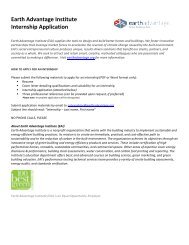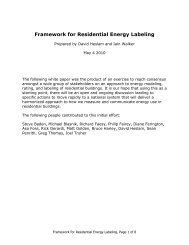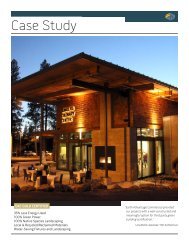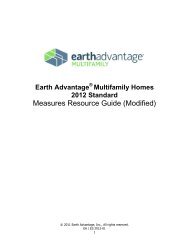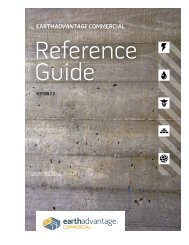EA New Homes Measures Guide - Earth Advantage
EA New Homes Measures Guide - Earth Advantage
EA New Homes Measures Guide - Earth Advantage
You also want an ePaper? Increase the reach of your titles
YUMPU automatically turns print PDFs into web optimized ePapers that Google loves.
2012 <strong>Earth</strong> <strong>Advantage</strong> Residential<br />
<strong>Measures</strong> Resource <strong>Guide</strong><br />
8.3.4<br />
Test Soil: Implement Recommendations<br />
Accountability Form: Landscape<br />
Energy<br />
Materials<br />
Water<br />
0 0 1 0 1<br />
Description: Soil test of site soil conditions is performed by soil testing lab and recommendations are implemented with soil amendments<br />
to entire landscaped area. Samples should be taken from various areas in the yard -- front yard, side yard, back yard -- wherever plantings<br />
will happen. When sending the sample to a soil testing laboratory, they should be notified that recommendations are for native plants, low<br />
water use landscape, etc., so their recommendations are suitable.<br />
Health<br />
Land<br />
Benefit: Soil tests will ensure that nutritional requirements of landscape plants are addressed. This will help plants to become established<br />
quickly. Over the long term the plants will use less water and require less fertilizer to remain healthy.<br />
Verification: Landscaper will provide an Accountability Form and copy of the laboratory results and work order implementing the<br />
recommendations.<br />
8.3.5<br />
One Tree per 1000 sq. ft. of Developed Landscape Area<br />
Energy<br />
Health<br />
Materials<br />
Water<br />
0 0 2 0 0<br />
Description: Plant at least one tree for each 1,000 sq. ft. of total lot area. The number of trees planted or on site is determined by adding<br />
up all of the area to be developed for landscaping and dividing it by 1000 to determine the number of trees to claim this measure.<br />
Land<br />
Benefit: Trees contribute significantly to the economic and ecological value of a site. In addition to their physical beauty, trees provide<br />
wildlife habitat and they help manage the flow of stormwater. They clean the air, and they protect critical features such as stream buffers<br />
or hillsides. In addition, properly trimmed and positioned trees protect the house from the cold winter winds and the hot summer sun,<br />
reducing heating and cooling bills. Considering the effects on energy usage, erosion control, pollution, and wildlife habitat, a single mature<br />
tree adds substantial annual and resale value. (Cooling Our Communities, A <strong>Guide</strong>book on Tree Planting and Light-Colored Surfacing, U.S.<br />
Environmental Protection Agency, 1992.)<br />
Trees protect soil and the house. They provide the ability to create a microclimate around the house. They also help reduce evaporation<br />
and reduce Heat Island Effect of the site. Young trees may use as much or more than the evaporation prevented.<br />
Here are a few recommendations: 1) Create a planting area with large soil storage for long term water needs; 2) low-water species<br />
selection; 3) Watering regime to establish large root zone in the first three years after planting the tree; 4) trees should be 1" caliper at one<br />
foot from the ground and approximately 6' tall.<br />
It is recommended that the landscaper identify where utility services are, or will be installed, and select and plant trees according to<br />
industry practices.<br />
Verification: <strong>EA</strong> Rater will count the number of newly planted trees and estimate the area of developed landscape in order to calculate the<br />
1 tree per 1,000 sq. feet target.<br />
Page 62 of 70



